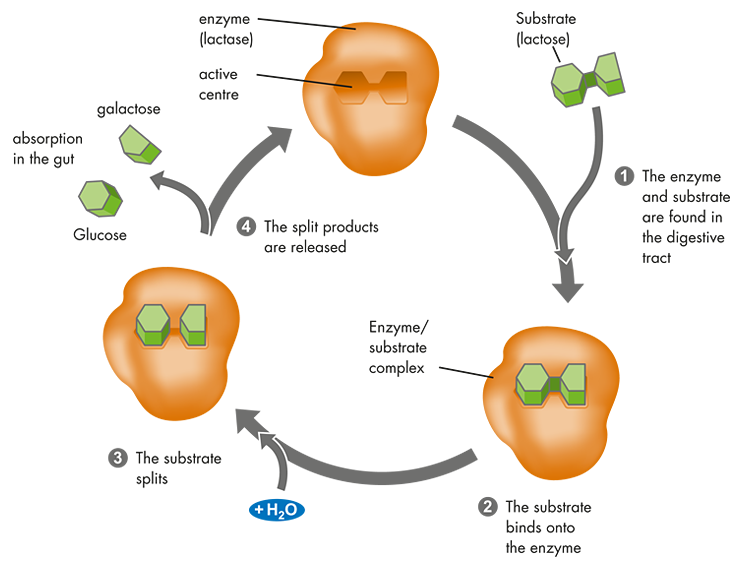 Enzymes, formerly also known as ferments, are usually high-molecular proteins. They function as biocatalysts in the somatic cells by enabling the material conversion under physically unfavourable conditions (low pressure and temperature). Like all catalysts, enzymes accelerate the chemical reactions by lowering the activation energy required for the material conversion. Compared to uncatalysed reactions, the material transformation is in this way increased by around a thousand to a million times, which enables many vital processes in the first place. If the enzymatic function fails, then life will also fail.
Enzymes, formerly also known as ferments, are usually high-molecular proteins. They function as biocatalysts in the somatic cells by enabling the material conversion under physically unfavourable conditions (low pressure and temperature). Like all catalysts, enzymes accelerate the chemical reactions by lowering the activation energy required for the material conversion. Compared to uncatalysed reactions, the material transformation is in this way increased by around a thousand to a million times, which enables many vital processes in the first place. If the enzymatic function fails, then life will also fail.
The effectiveness of enzymes to enable to conversion of substances is described as enzyme activity. It is a measure of the catalytic activity of enzymes and mirrors the substrate turnover per unit of time. The parameter for enzyme activity is the katal (kat), whereby 1 kat corresponds to a turnover of 1 mol, that is 6 x 1023 substrate molecules per second (mol x s-1). A commonly used measurement used in medical literature is the International Unit (U), whereby one U corresponds to the turnover of 1 µmol of substrate per minute (µmol x min s-1 or 16.7 x 10-9 kat). Another measurement used for enzyme activity in biomedicine is the FIP unit (Fédération International Pharmaceutique), whereby 1 FIP unit corresponds to the quantity of enzymes which convert 1 µmol of a defined substrate in 1 minute under standard conditions.
Enzymes have highly specific functions by only converting specific substrates (known as substrate specificity) and exhibit a distinct specificity of effect, i.e. only enabling a certain substance conversion. So that they can unfurl their full activity, many of them are reliant on “activators”. These additionally required components are referred to as cofactors. These firstly involve minerals such as magnesium, iron and copper, as is the case for metalloenzymes or metal activated enzymes. Other enzymes, in contrast, require organic or metal-organic cofactors, which are referred to as coenzymes. Many vitamins are components of coenzymes.
Diagram of an enzymatic split
Multi-enzyme complexes can improve the digestive capacity of people with a reduced digestive capacity and also those with a fully functioning digestion to achieve a higher absorption of nutrients.
This allows certain enzymes extracted from plants and microbes to offer the advantage of being stable in gastric juices and are thus being active in the stomach even during the pre-digestion phase (approx. 0.5 to 5.0 hours) which allows a more effective breaking down of food to take place.
This is one of the reasons that Intercell Pharma offers exclusively non-animal enzymes. There is a choice of 15 different enzymes available which have been developed into specific formulations.
Functions of enzymes
Enzymes required for the breakdown of food are classed as hydrolases. They catalyse the splitting of higher molecular nutritive mediums into smaller fragments with the adsorption of water – required for the absorption of nutrients into the gut wall. Depending on the nutritive substrate, differentiation is made between:
- Lipases split the lipids supplied by the food, predominantly neutral fats, into their monomer building blocks (fatty acids, glycerine or monoglyceride).
- Glycosidase splits carbohydrate structures, including disaccharides such as maltose (enzyme: maltase), marginal dextrins (sucrase or sucrase-isomaltase), starch and fragments of starch (α-Amylase) and higher molecular galactose compounds (α-Galactosidase). A glycosidase with pronounced substrate specificity is lactase, a milk sugar-splitting enzyme.
- Proteases split the peptide compounds between amino acids. Known plant agents are bromelain and papain. Bromelain belongs to the group of cysteine proteases and is extracted from pineapple plants and fruits. Papain is also a cysteine protease. The raw materials are the core, green skins and the latex from unripe papaya fruits. Both proteases are effective in the whole body, topically in the gastrointestinal tract as well as systemically after dose-dependent absorption.
Useful information.
- For people who have problems digesting lactose, lactase improves the digestion of lactose.
- Multi-enzyme complexes can improve the digestive capacity of people with a reduced digestive capacity and also those with a fully functioning digestion to achieve a higher absorption of nutrients.
- This allows certain enzymes extracted from plants and microbes to offer the advantage of being stable in gastric juices and are thus being active in the stomach even during the pre-digestion phase (approx. 0.5 to 5.0 hours) which allows a more effective breaking down of food to take place.
Information on production technology
- Intercell Pharma offers exclusively non-animal enzymes. There is a choice of 15 different enzymes available which have been developed into specific formulations.
© Intercell Pharma GmbH




